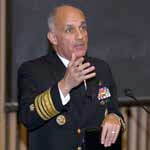
U.S. Surgeon General Richard H. Carmona, who visited the Health Science Center for a Feb. 24 symposium on obesity in the Hispanic population, suggested that if the public viewed the current epidemic of obesity with the same seriousness as potential acts of bioterrorism, the United States would take a solid and necessary step toward becoming a healthier nation.
“Obesity is the terror within,” said Vice Adm. Carmona, an Arizona trauma surgeon appointed by President Bush in 2002 to head the U.S. Public Health Service. “It is eroding our society. It will bring a disease burden we can’t afford.”
Nine million children are obese or overweight, which has “huge” workforce implications for the military and the country, Vice Adm. Carmona said. Lack of health literacy compounds the problem. “The average American can’t read a food label or medicine dosage instructions,” he said. “The best science we have is stuck here because we can’t get it to the people who need it.”
Francisco G. Cigarroa, M.D., president of the Health Science Center, and Brig. Gen. C. William Fox Jr., commanding general of Brooke Army Medical Center and the Great Plains Regional Medical Command, welcomed Vice Adm. Carmona, whose address concluded the afternoon symposium held by the Southwest Research Consortium of San Antonio. The symposium featured a trio of researchers who described scientific and intervention projects aimed at obesity and the disease it often precedes, type 2 diabetes.
Invited speaker Ralph DeFronzo, M.D., said type 2 diabetes actually is two different diseases in that it affects the microvasculature, damaging blood vessels in the eyes, kidneys and feet, as well as the macrovasculature, resulting in heart attack and stroke. The ideal oral therapeutic agents will deal with both disease courses, he said. Dr. DeFronzo is professor of medicine and chief of the diabetes division at the Health Science Center, deputy director of the Texas Diabetes Institute and staff physician with the South Texas Veterans Health Care System.
Researchers are changing their concept of type 2 diabetes development to add “the fourth musketeer – the fat cell,” Dr. DeFronzo said. “What has changed in the last 20 years? Not the genes, but the amount of fat in our bodies.” The fat cell produces large amounts of inflammatory molecules that increase the risk of cardiovascular events in type 2 diabetics, he noted.
A United Kingdom study of the medication metformin, now widely prescribed for type 2 diabetes, showed a 29 percent decrease in the occurrence of microvascular complications and a 39 percent drop in cardiac arrests, a 41 percent reduction in strokes and a 42 percent decrease in deaths, he said. Other agents called thiazolidinediones and sulfonylureas also are effective. “There is really no reason we can’t control patients’ diabetes with oral agents,” Dr. DeFronzo said.
Anthony Comuzzie, Ph.D., scientist with the Southwest Foundation for Biomedical Research, discussed research in extended families to uncover genes that play a role in obesity and development of type 2 diabetes. In the past, investigators have concentrated on finding candidate genes and more than 200 have been suggested. “But trying to choose a single gene out of the 30,000 to 40,000 genes we know to exist is really a long shot,” Dr. Comuzzie said. “Many of us have adopted a genome scan approach.” This is an effort to create a map of many genetic variations in families across the entire genome. This research is made possible by access to high-end computing resources to accommodate millions of bits of information. The Foundation has the largest cluster computing facility dedicated to genome research in the world, Dr. Comuzzie said.
Gene regions on human chromosomes 2, 3, 5, 6, 8, 10, 11, 17, 18 and 20 are being evaluated for relationship to childhood obesity and metabolic syndrome, he noted.

